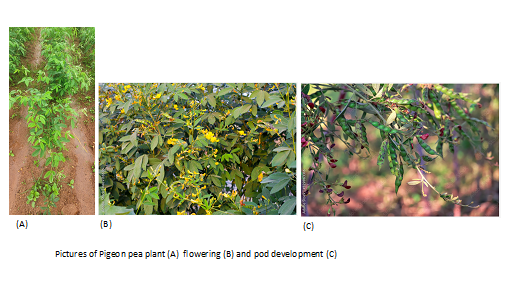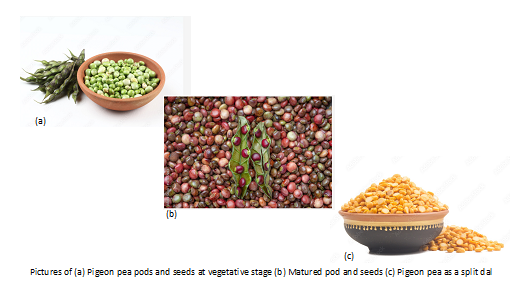Pigeon pea: Plant information, History, and Nutrition
Cover picture – Credits to: ICRISAT RP 11C. P.S: Mr. Satyanarayana Mogilicherla, Senior officer of agriculture, ICRISAT-Patancheru, Hyderabad- India.
Pigeon pea, scientifically known as Cajanus cajan. Some of its common names are red gram, tur, or Arhar. Pigeon pea is a versatile legume crop that holds significant cultural, historical, and nutritional value. With origins in the Indian subcontinent, this plant has “spread its roots” across tropical and subtropical regions of the world (Upadhyaya et al., 2013), becoming a staple in various cuisines and an essential component in sustainable agriculture.
It is the sixth most important legume in the world, and more than 85% of the total pigeon pea production and consumption is in India. In this country, the crop has a key role in the food and nutritional security of the people. Major pigeon pea growing areas in India are: Karnataka, Maharashtra, Madhya Pradesh, Gujarat, and Uttar Pradesh. Odisha, and Jharkhand. 
Plant Information – Pigeon Pea Physiology
The pigeon pea plant is a small perennial shrub that belongs to the Fabaceae family. It is generally cultivated as an annual crop and, in India, can be used in crop rotation and intercrop systems with different cereal crops. The plant reaches a height of 1 to 4 meters, featuring compound leaves with three leaflets. The plant produces stunning yellow or red flowers, followed by elongated pods containing edible seeds (2-9). There are numerous pigeon peas cultivars, differing in size, color, and adaptability to different climates and soil conditions.
Pigeon pea cultivated types can be grouped into two varieties. C. cajan (L.) Millsp., var. bicolor DC., Hindi name arhar, a late maturing, large, bushy plant which usually takes 6-11 months to reach maturity, and the other one is a short-season variety, C. cajan, var. flavus DC., Hindi name tuvar, which can reach maturity more rapidly, within 3-4 months.
This crop is typically grown in black to deep black cotton soils, well-drained with a pH ranging from 7.0-8.5, and temperature ranging from 26 – 30° C in a rainy season (June to October), with annual rainfall of 600-1000 mm yet is also drought tolerant and it is also suitable for areas with < 300 mm rainfall (Kingwell-Banham & Fuller, 2013). Therefore, it is an important crop for small-scale farmers in semi-arid areas with low or variable rainfall.

History, Importance and Cultivation of Pigeon Pea
The cultivation of pigeon peas dates back thousands of years, with evidence of their domestication happening in the Indian subcontinent as early as 3,500 BC. It originated in India from its progenitor Cajanus cajanifolius. From there, pigeon peas spread to Australia, Africa, the Americas, and other parts of Asia, becoming an integral part of local cuisines and agricultural systems (Van de Maesen, 1980).
The other theory suggesting Africa as the center of origin does not seem to be viable as only one wild relative, C. kerstingii, is reported to occur in West Africa. In addition, C. scarabaeoides has also been found in Africa, but its spread is restricted to the coastal area only. Consequently, van de Maesen (1980) proposed Africa as the secondary center of origin (Saxena, 2010). Therefore, the most acceptable route of dispersion describes that the immigrants moved the crop up from India to East Africa, then route followed to Egypt (via Nile valley), West Africa, and finally to America (Odeny, 2007; Kassa et al., 2012). In Australia also, around fifteen wild species have been reported.
Pigeon peas have played a significant role in subsistence farming due to their ability to tolerate drought, poor soil conditions, and pests. They are often intercropped with other crops, such as cereals and vegetables, contributing to soil fertility through nitrogen fixation. The plant’s deep taproot system helps prevent soil erosion, making it a valuable component of sustainable farming practices.
Nutritional Value and Health Benefits of Pigeon Peas
Pigeon peas are not only a vital food source but also a nutritionally dense legume. They are a great source of plant-based protein, containing approximately 22 grams per 100 grams of cooked peas. This makes them an ideal protein alternative for vegetarians and vegans, and due to their high protein content, it is generally called ‘poor people’s meat’ or ‘orphan crop’.
It contains protein (18-25%), starch (45-60%), crude fiber (8.2%), and fat (2.3%). It has the best amino acid balance to fulfill the daily nutrient requirements as well as minerals like calcium and magnesium in good amounts (Patel and Khatri et al., 2021)
Furthermore, pigeon peas are rich in dietary fiber, which aids in digestion, promotes satiety, and helps maintain a healthy weight. They are also abundant in essential vitamins and minerals, including vitamins A and C, folate, potassium, and iron. These nutrients support the immune system, healthy blood circulation, and well-being.
Health Benefits: The consumption of pigeon peas offers several health benefits. The high fiber content help in reducing the risk of type 2 diabetes since it regulates blood sugar levels. Potassium helps maintain healthy blood pressure levels, reducing the chances of cardiovascular diseases. Additionally, pigeon peas’ iron content is crucial for producing red blood cells and preventing iron-deficiency anemia.
Incorporating Pigeon Peas into Your Diet: Pigeon peas can be cooked and enjoyed in various ways. They are commonly used in stews, soups, curries, and rice dishes. The peas can be soaked and boiled until tender or ground into flour to create versatile culinary ingredients. Immature pods may be cooked in curries and other relishes (Orwa et al., 2009). Roasted pigeon peas make for a nutritious and flavourful snack. In addition to their culinary uses, pigeon peas are also utilized for animal feed and green manure in agriculture.

References:
Hari D. Upadhyaya, Shivali Sharma, K.N. Reddy, Rachit Saxena, Rajeev K. Varshney and C.L. Laxmipathi Gowda, 2013. Pigeonpea book chapter, pages 181-202. Book: Genetic and genomic resources of grain legume improvement
Kassa MT, Varma Penmetsa R, Carrasquilla-Garcia N, Sarma BK, Datta S, Upadhyaya HD, Varshney RK, von Wettberg EJB, Cook DR (2012) Genetic patterns of domestication in pigeonpea (Cajanus cajan (L.) Millsp.) and wild Cajanus relatives. PLOS 35:65. https://doi.org/10.1371/journal.pone.0039563
Kingwell-Banham E, Fuller DQ (2013) Pigeonpea: origins and development. In: Smith C (ed) Encyclopedia of Global Archaeology. Springer, New York, pp 5941–5944
Orwa, C.; Mutua, A.; Kindt, R.; Jamnadass, R.; Anthony, S., 2009. Agroforestry Database: a tree reference and selection guide version 4.0. World Agroforestry Centre, Kenya
Odeny DA (2007) The potential of pigeonpea (Cajanus cajan (L.) Millsp.) in Africa. Natural Resources Forum 31: 297-305
Patel P.T., and Khatri A.B. 2021. Cajanus Cajan (L.) millsp. Cultivation, use, and Nutrition. Book chapter. Pages 135-155
Saxena KB, Kumar RV, Sultana R (2010) Quality nutrition through pigeon pea-a review. Health 11: 1335-1344
Van der Maesen LJG (1980) India is the native home of the pigeon pea. In: Arends JC, Boelema G, De Groot CT, Leeuwenberg AJM (eds) Liber Gratulatorius in Honorem H.C.D. De Wit. Miscellaneous Papers 19 (1980) Landbouwhoge school, Wageningen, the Netherlands. H. Veenman & Zonen B.V., Wageningen, pp 257–262
Further reading
Pigeon pea: Plant information, History, and Nutrition
Principles of selecting the best varieties and hybrids for Pigeon pea cultivation
Pigeon pea Soil requirement, Soil preparation and Plant density
Irrigation requirement for Pigeon pea Cultivation
Fertilization requirement for Pigeon Pea
Weed Management in Pigeon Pea Farming
Pigeon pea Diseases and Management Practices










































































